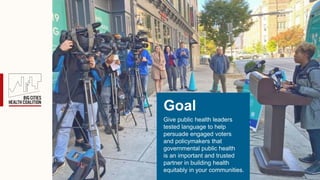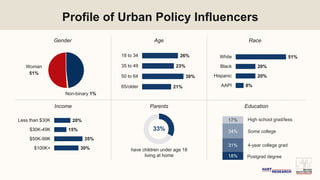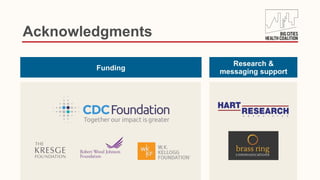Structural Racism and Public Health: How to Talk to Policymakers and Community Members
- 1. Structural Racism and Public Health: How to Talk to Policymakers and Community Members TUESDAY, NOVEMBER 28 3:00-4:30pm ET / 12:00-1:30pm PT This event will be recorded. The recording and slides will be available on publichealthcollaborative.org later this week. All attendees are automatically muted upon entry.
- 2. Closed Captioning and ASL Interpretation Live closed captioning is being provided by AI Media. ASL interpretation is being provided by Keystone Interpreting Solutions. If you’d like to use closed captions or ASL interpretation, hover over the “More” button or the “Interpretation” button on the bottom of your Zoom screen.
- 3. Meet Today’s Experts Tom Martin Communications Director CityHealth Dr. Elizabeth Green Communications Director Big Cities Health Coalition Dr. Judy Monroe President and CEO CDC Foundation Allyn Brooks-LaSure Vice President, Communications Robert Wood Johnson Foundation Dr. Raynard Washington Public Health Director Mecklenburg County Public Health
- 4. Promoting Health Equity in Big Cities Key findings from focus groups, online discussion boards, and an online survey of policy influencers living in large cities Find further details about this study on BCHC’s website.
- 5. Give public health leaders tested language to help persuade engaged voters and policymakers that governmental public health is an important and trusted partner in building health equitably in your communities. Goal
- 6. Methodology • Two focus groups with white centrist and Black residents living in Philadelphia, March 2023 • Two online discussion boards with white center-right and Black and Hispanic residents living in BCHC’s 35 member cities, March 2023 • Online survey of 1,006 “policy influencers” (news- attentive, civically engaged voters) in BCHC’s 35 member cities, May 2023 • Includes oversamples of Black and Hispanic policy influencers Seattle, WA Houston, TX Dallas, TX El Paso, TX Fort Worth, TX Austin, TX San Antonio, TX Memphis, TN Baltimore, MD Washington, DC New York, NY Philadelphia, PA Boston, MA Phoenix, AZ Tucson, AZ Denver, CO Long Beach, CA San Diego, CA San Francisco, CA Oakland, CA San Jose, CA Las Vegas, NV Los Angeles, CA Portland, OR Kansas City, KS Oklahoma City, OK Chicago, IL Indianapolis, IN Detroit, MI Minneapolis, MN Milwaukee, WI Charlotte, NC Cleveland, OH Columbus, OH Louisville, KY
- 7. Profile of Urban Policy Influencers Man 48% Non-binary 1% Woman 51% Gender Age 26% 23% 30% 21% 18 to 34 35 to 49 50 to 64 65/older Education Race Income Parents 17% 34% 31% 18% 51% 20% 20% 8% White Black Hispanic AAPI 20% 15% 35% 30% Less than $30K $30K-49K $50K-99K $100K+ High school grad/less Some college 4-year college grad Postgrad degree have children under age 18 living at home 33%
- 8. Urban Policy Influencers’ Engagement with News, Civic Issues Read/Listen to News Involvement in Issues Ideology Party ID Very involved 22% Somewhat involved 78% 65% 35% Six or seven days a week Four or five days a week 60% 24% 16% Democrat Republican Independent 45% 22% 33% Liberal Conservative Moderate
- 10. Reducing crime and addressing homelessness are the largest priorities for policy influencers. Traditional public health investments are a second-tier concern. This issue should be a TOP PRIORITY for the city I live in to address.
- 11. In their own words, homelessness, substance use disorder, and mental health are the most important health-related issues to address. What are the most important health-related issues to address and improve in your city? (Open-ended)
- 12. Health priorities vary somewhat by region. What are the most important health-related issues to address and improve in your city? (Open-ended) National % CA % Rest of W % NE % Midwest % TX % Rest of S % Homelessness 18 33 24 18 7 16 13 Substance use disorder 18 15 28 26 11 8 21 Mental health 15 13 12 20 16 14 12 Access to healthcare 13 12 10 12 14 17 9 Obesity 10 4 4 5 14 18 18 COVID-19 9 12 8 11 8 7 12 Diabetes 9 8 3 10 8 17 6 Affordability of healthcare 9 8 7 8 8 12 12 Air quality 9 11 12 8 7 8 6 Crime/gun violence 7 3 6 12 9 2 10 Respiratory issues/diseases 6 7 9 4 6 4 5 Highest value Higher than national average
- 13. A few specific social determinants of health stand out to policy influencers as especially important. Livable wage Safe, affordable housing Healthy food Learn more about BCHC’s Urban Health Agenda.
- 14. 36% 42% Shifting to an “empowerment” framing can increase their perception that city government has responsibility in the health realm. The city government should have A LOT OF RESPONSIBILITY to... Help residents to be healthy* Make sure residents have opportunities to be healthy* * Each asked of half the respondents. All policy influencers Liberal Democrats Non-liberal Democrats Independent s Republicans White residents Black residents Hispanic residents Men Women NYC/LA/CHI/PHL City Pop. 800K-1M City Pop. 500K-800K City Pop. <500K 42% 33% 28% 34% 38% 41% 39% 34% 37% 38% 36% 34% 51% 37% 39%44% 30% 36% 53% 47% 36% 47% 42% 53% 32% 41%
- 15. Qualitative Findings White influencers thought income-based health disparities were a greater priority than racism-based health disparities. Black and Hispanic influencers saw these as interrelated. I think catering to a specific group of people, other than low-income persons as a whole, creates divisiveness and bias. —White Woman, Columbus, Independent I think the bigger topic would be to bring it to everyone instead of concentrating on one group over another. Being able to make sure that everyone gets their share is better, in the long run, than trying to catch people up while focusing on others. —Boston, Hispanic Man, Independent
- 16. But when we framed racial health inequities through an empowerment message – people created the issue, people can fix it – policy influencers showed more support. Racial health inequities are a result of social and economic systems that have been made by people, and therefore can be changed by people as well. Addressing racial health inequities will require examining and addressing the root causes of these disparities, including unequal access to health care and distribution of resources. But by acknowledging that these inequities are manmade and fixable, we can begin to take the necessary steps to create a more fair and just society. 57% chose this as the best case for addressing racial health inequities (top vote getter)
- 18. Speaker Dr. Judy Monroe President and CEO CDC Foundation
- 19. Public Health: Changing the Narrative— Research-Based Messaging Guide
- 22. State investment in local public health Services delivered at the county level Evidence-based programs focused on prevention Counties decide whether to opt in Health First Indiana
- 24. Speaker Allyn Brooks-LaSure Vice President, Communications Robert Wood Johnson Foundation
- 25. Leading with values • Values work better than examples, stories, or facts. • Don’t lead with facts or statistics. In the survey, voters reacted with low intensity to statements that lead with statistics or facts. • Stories that show the condition and impact of structural racism—along with a solution—are convincing. Just don’t lead or dominate with them.
- 26. Why Values? • Anchoring messaging in values and emotion versus facts and statistics is vital. • People make decisions based on their values, then look for facts to reinforce their values—especially in conversations about issues linked to personal identity. • Survey respondents rated values-based messages more favorably than problem-based messages.
- 27. • Problem-Based Examples: • In America, nearly 11 million children are poor. • Black men have a higher incidence and mortality rate of prostate cancer • Values-Based Example: • We all have dreams for ourselves and our families. • But too many of our children… • But too many of our fathers/husbands… Problems vs. Values
- 28. Building support for race and equity policies in health is critical, but how do we effectively translate research into action? Building on RWJF’s “Structural racism and health” messaging research, We Make The Future’s two-part workshop will equip you with the tools you need to implement race-forward health messaging to build support for healthy equity approaches. During the workshops, we will: 1. Dig deeper into implementation strategies; 2. Brainstorm ways you can effectively use a race and class explicit message in your day-to-day work and ongoing public health campaigns; 3. Practice writing messages that lead with values, describe the effects of structural racism on health, and help your audience think about this issue at a structural—not just an individual—level. Ready to turn research into action and strengthen your messaging tactics? Please fill out this form to RSVP: bit.ly/wmtf-workshop Structural racism and health implementation workshop
- 30. Speaker Dr. Raynard Washington Public Health Director Mecklenburg County Public Health
- 31. Thank You More Resources www.publichealthcollaborative.org Contact [email protected] Follow PHCC X: @PH_Comms LinkedIn: Public Health Communications Collaborative






























